Go and catch a falling star notes pdf - ppup part 1 english honours notes and study material pdf
[ Go and catch a falling star notes pdf | ppup part 1 english honours notes and study material pdf ]
In this BlogPost we'll cover These Topics - ppup part 1 english honours notes and study material pdf, PPUP part 1 english honours ug study material download, PPUP part 1 english honours ug study material free, PPUP part 1 english honours ug study material online, PPUP part 1 english honours ug study material pdf, PPUP part 1 english honours ug study material quora, patliputra university guess paper 2024 pdf, Go and catch a falling star notes pdf, Go and catch a falling star poem, Go and catch a falling star notes summary, Go and catch a falling star poem Summary, Go and catch a falling star Question answer
Go and catch a falling star Analysis, Go and catch a falling star line by line explanation, Go and catch a falling star as a metaphysical poem
Introduction to Go and catch a falling star notes pdf
About the Poem of Go and catch a falling star notes pdf
About the Author Go and catch a falling star notes pdf | ppup part 1 english honours notes and study material pdf
Go and catch a falling star line by line explanation to its context
Go and catch a falling star notes summary
Critical Analysis of Go and catch a falling star | ppup part 1 english honours notes and study material pdf
Discuss the Theme of Go and catch a falling star notes pdf
Conclusion for Go and catch a falling star notes pdf
I hope You got what you were looking for ..reading this post Go and catch a falling star notes pdf | ppup part 1 english honours notes and study material pdf ... and if you got any query ..you can comment below so we can provide you further assistance.



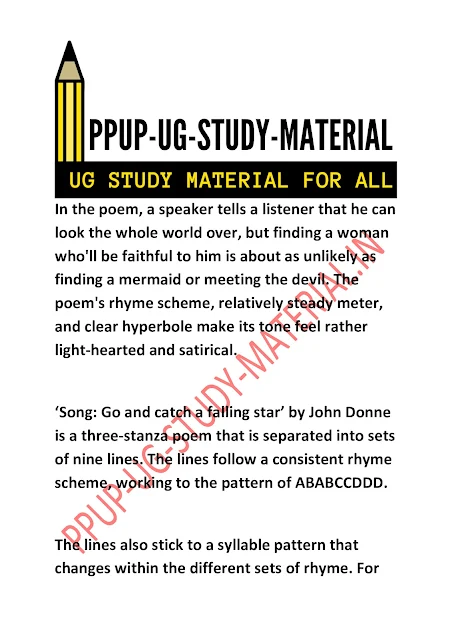








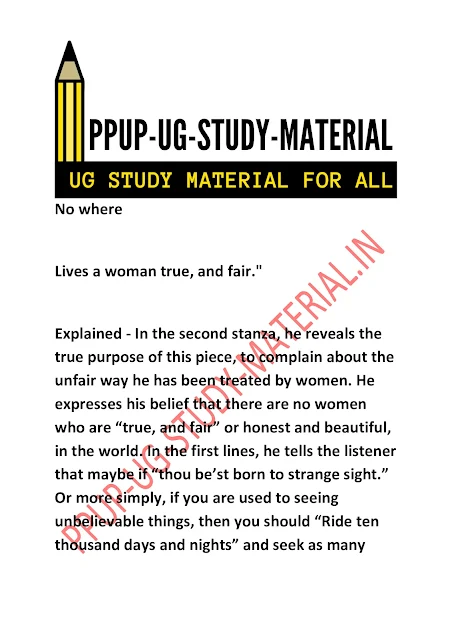










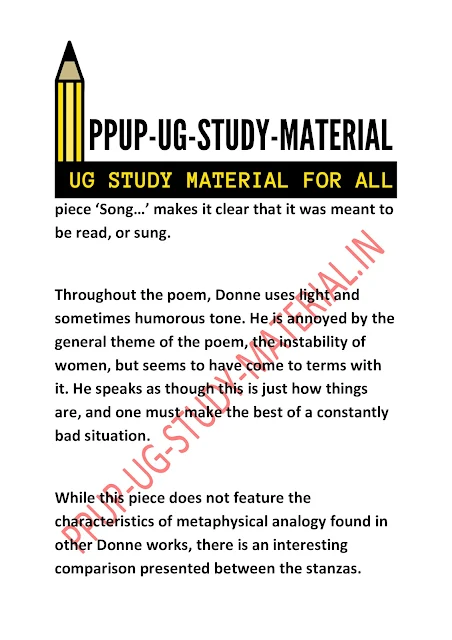



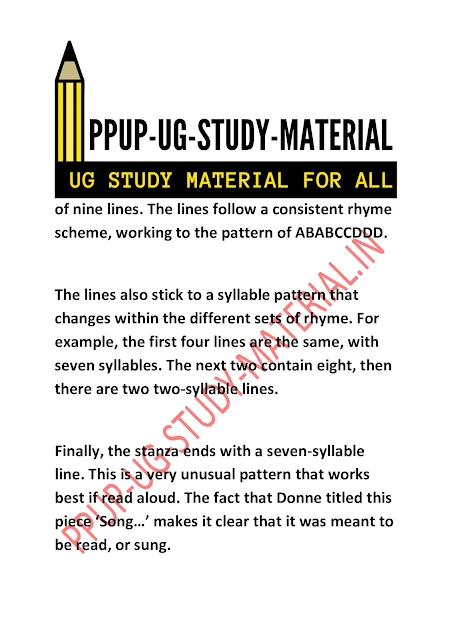










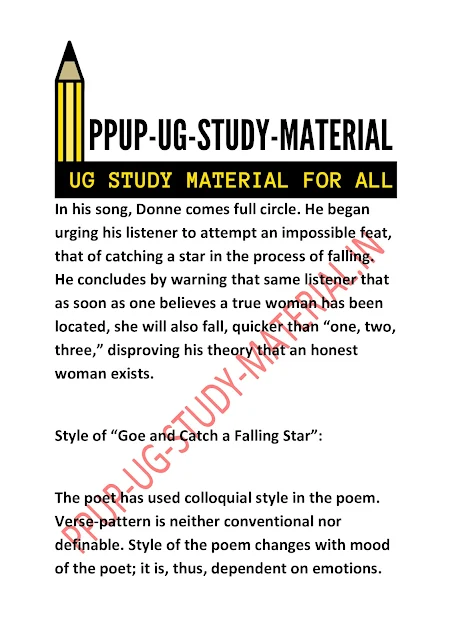
![Critical Analysis of Go and catch a falling star | ppup part 1 english honours notes and study material pdf Tones Sometimes the tone is magical: ‘Go and catch a falling star’. Sometimes the tone is harsh and cruel: ‘Get with child a mandrake root’ Sometimes the tone is self-pitying: ‘envy's stinging’. Sometimes the tone is petulant [bitchy]: ‘I would not go, though at next door we might meet.’ Sometimes the tone is commanding or bossy: ‘Go …Get…Tell…Teach’. Sometimes the tone is hopeful and caring: ‘If thou find'st one, let me know,](https://blogger.googleusercontent.com/img/b/R29vZ2xl/AVvXsEiHD7tbaYTAr0WgdRV04vlkPAZustpdpC1cQsaPyO3Fi8gKZw8qwBKWnfFtp6RPw02YmiEJCgfUPUyYbx97f5DllA7fxYUUq4L9CjsCb0JpbGg7vKnlfvak1dPV7CjRes2H408LBTm-AK02VYbzwGam-VJjtlSuqqCVoJ8y9kJz8XDy1PMGZ2FUC9Kr/w452-h640-rw/Go%20and%20catch%20a%20falling%20star%20notes%20pdf-37.jpg)


![Critical Analysis of Go and catch a falling star | ppup part 1 english honours notes and study material pdf Sound effects Alliteration[the repetition of first letters]:The repeated ‘b and 's’ sounds in ‘If thou be'st born to strange sights’. Assonanc [repetition of vowels]: The ‘a' sounds in ‘Go and catch a falling star’. Rhyming: There is a regular pattern.[The first and third lines rhyme, the second and fourth lines rhyme, the fifth and sixth lines rhyme as acouplet and](https://blogger.googleusercontent.com/img/b/R29vZ2xl/AVvXsEjbI0lznbFJ05g3HA0mjlBi4I9nb_m6PdAHupQkv7vi_IL9pLK7E0ZzOCeJDFlzOZKbt5rc5-4FWDpGKNmudHvpj3GvHP2bhZFWt0kWbz5oh3VVm-HPEsaxZDNo-ibvB3QPw4I6aj28HwrDhA_L7IQyFHE8b5yi37rAgJq-ogO8TZJzhefPpcdxkh1Z/w452-h640-rw/Go%20and%20catch%20a%20falling%20star%20notes%20pdf-40.jpg)
![Critical Analysis of Go and catch a falling star | ppup part 1 english honours notes and study material pdf the last three lines rhyme at the end of each stanza]:The end sounds in the first stanza are as follows:‘ar’, ‘oot’, ‘are’, ‘oot’, ‘ing’, ‘ing’, ‘ind’, ‘ind’, ‘ind’.There is clearly a regular pattern. Theme: The song is actually on feminine inconstancy. Its theme is the lack of fidelity of women. According to the poet, no woman, who is both true and fair, can be traced anywhere. This is well struck in the last two lines of the second stanza: “No where ,Lives a woman, true and fair.”](https://blogger.googleusercontent.com/img/b/R29vZ2xl/AVvXsEj1WAxKTb647bxPjSUIUfd08gL9F15Y64XFKoKEMOcJWdHagWl3UAI8bD9a5NByy8bnAUQvKPM0lc_bh4D6DXvrGA1geTS1ISot7DgefPerfnTHqnSYMNR8rUByGt2DB3EOsnUuSDzeVKphtqxcZH6HW9U9WOe84q7jKFXHtDJ0-S4xnysjZJD0vI0n/w452-h640-rw/Go%20and%20catch%20a%20falling%20star%20notes%20pdf-41.jpg)



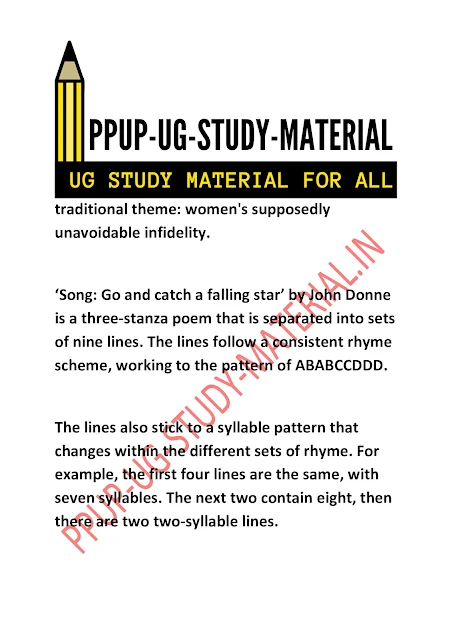








No comments